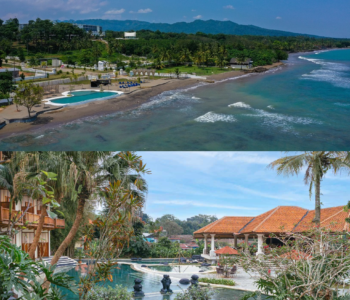The role of technology is infinite. Not only does technology ease everyday life, it also plays an important part to increase the interaction between a city and its citizens. Many modern cities worldwide now focus on technology optimization in order to create intelligent cities, and as Indonesia’s biggest metropolis, Jakarta is certainly taking part in this current movement through various efforts and innovations.
 Jakarta Smart City According to its official website, Jakarta Smart City is implementing intelligent concepts through technology and communication development in order to achieve better public services. The concept of smart city is also expected to improve public and government interactions, especially in utilizing data and applications as well as to facilitate citizens to easily voice their opinion about their city.
Jakarta Smart City According to its official website, Jakarta Smart City is implementing intelligent concepts through technology and communication development in order to achieve better public services. The concept of smart city is also expected to improve public and government interactions, especially in utilizing data and applications as well as to facilitate citizens to easily voice their opinion about their city.  Jakarta Smart City has six indicators, namely Smart Governance (more transparent, informative and responsive government), Smart Economy (to boost productivity with entrepreneurship and the spirit of innovation), Smart People (improving the quality of human resources and public facilities), Smart Mobility (provision of transportation and infrastructure system), Smart Environment (managing eco-friendly natural resources), and Smart Living (realizing a healthy and livable city). The implementation of Jakarta Smart City can be seen through various projects. As one of the efforts to achieve a better connected city, Jakarta Smart City has two mobile applications, QLUE and Cepat Respon Opini Publik (CROP), or Quick Response Public Opinion. QLUE is a social media application that can be downloaded on Andorid-based smartphones. Through the app, the public can make direct reports with real-time photos on any events like traffic congestion, law violation, natural disasters, floods and many more in order to get a quick response from Jakarta’s officials and law enforcers. Citizens act as a source of data as they are able to send any information to a data centre which later will be consumed by other customers. Not only can they deliver complaints, but citizens are also welcome to share any interesting information about culinary, tourism, as well as public services in Jakarta. They can also give their appreciation directly to the government officials who have helped to solve Jakarta’s problems. On the other hand, CROP is an application that comes in handy for Jakarta Provincial Government officials as it provides information about any complaint filed by citizens so they can be addressed immediately. In addition to these two mobile apps, Jakarta Smart City continuously creates various innovations to make Jakarta better, including its CityTouch Technology for Jakarta’s street lighting. CityTouch technology is a web-based information management system focusing on long distance monitoring and maintenance street lighting. With this system, a periodic physical examination is no longer required and any disturbance or damage to street lights can be monitored in real time. Supported by LED-based technology, the system can save electrical energy up to 40 percent compared to conventional street lights. These potential savings could further grow by 60 to 70 percent due to a dimming control capacity according to environmental needs without compromising the safety of road users. This is one of the biggest CityTouch projects in the world, and Jakarta holds the record for the fastest luminaire installations due to its timely mounting, which is an important milestone during Jakarta’s journey to become a Smart City. The Future of Transportation Traffic congestion, indecent public transportation and impossible sidewalks are undeniably major issues in the city. Citizens often spend hours on the streets as gridlocks are part of the daily grind in Jakarta. Dealing with heavy traffic has many negative consequences: it limits the citizens’ productivity and can also become a trigger of stress. So it is only right for the government to take concrete steps and make cutting-edge public transportation alternatives that can solve this problem effectively in the future. TJ Card Since November 2016, a special card called TJ Card to enjoy Transjakarta bus rides free of charge has been distributed among the elderly, the disabled, veterans, holders of the Social Security Card and the residents of the Thousand Islands.
Jakarta Smart City has six indicators, namely Smart Governance (more transparent, informative and responsive government), Smart Economy (to boost productivity with entrepreneurship and the spirit of innovation), Smart People (improving the quality of human resources and public facilities), Smart Mobility (provision of transportation and infrastructure system), Smart Environment (managing eco-friendly natural resources), and Smart Living (realizing a healthy and livable city). The implementation of Jakarta Smart City can be seen through various projects. As one of the efforts to achieve a better connected city, Jakarta Smart City has two mobile applications, QLUE and Cepat Respon Opini Publik (CROP), or Quick Response Public Opinion. QLUE is a social media application that can be downloaded on Andorid-based smartphones. Through the app, the public can make direct reports with real-time photos on any events like traffic congestion, law violation, natural disasters, floods and many more in order to get a quick response from Jakarta’s officials and law enforcers. Citizens act as a source of data as they are able to send any information to a data centre which later will be consumed by other customers. Not only can they deliver complaints, but citizens are also welcome to share any interesting information about culinary, tourism, as well as public services in Jakarta. They can also give their appreciation directly to the government officials who have helped to solve Jakarta’s problems. On the other hand, CROP is an application that comes in handy for Jakarta Provincial Government officials as it provides information about any complaint filed by citizens so they can be addressed immediately. In addition to these two mobile apps, Jakarta Smart City continuously creates various innovations to make Jakarta better, including its CityTouch Technology for Jakarta’s street lighting. CityTouch technology is a web-based information management system focusing on long distance monitoring and maintenance street lighting. With this system, a periodic physical examination is no longer required and any disturbance or damage to street lights can be monitored in real time. Supported by LED-based technology, the system can save electrical energy up to 40 percent compared to conventional street lights. These potential savings could further grow by 60 to 70 percent due to a dimming control capacity according to environmental needs without compromising the safety of road users. This is one of the biggest CityTouch projects in the world, and Jakarta holds the record for the fastest luminaire installations due to its timely mounting, which is an important milestone during Jakarta’s journey to become a Smart City. The Future of Transportation Traffic congestion, indecent public transportation and impossible sidewalks are undeniably major issues in the city. Citizens often spend hours on the streets as gridlocks are part of the daily grind in Jakarta. Dealing with heavy traffic has many negative consequences: it limits the citizens’ productivity and can also become a trigger of stress. So it is only right for the government to take concrete steps and make cutting-edge public transportation alternatives that can solve this problem effectively in the future. TJ Card Since November 2016, a special card called TJ Card to enjoy Transjakarta bus rides free of charge has been distributed among the elderly, the disabled, veterans, holders of the Social Security Card and the residents of the Thousand Islands.  This new policy aims to attract more people to switch for public transportation which hopefully can lead to a reduction of traffic congestion and air pollution. Mass and Light Rapid Transit The need of a new public transportation system has become inevitable in Jakarta. Currently, the transportation modes in Jakarta are dominated by private vehicles; rail-based transportation only accounts for 2 percent. In order to reduce traffic significantly in the future, the Jakarta Provincial Government is currently developing two modes of public transport to solve the problem, namely the Mass Rapid Transit (MRT) and Light Rail Transit (LRT).
This new policy aims to attract more people to switch for public transportation which hopefully can lead to a reduction of traffic congestion and air pollution. Mass and Light Rapid Transit The need of a new public transportation system has become inevitable in Jakarta. Currently, the transportation modes in Jakarta are dominated by private vehicles; rail-based transportation only accounts for 2 percent. In order to reduce traffic significantly in the future, the Jakarta Provincial Government is currently developing two modes of public transport to solve the problem, namely the Mass Rapid Transit (MRT) and Light Rail Transit (LRT).  The main idea behind MRT and LRT development is to reduce the number of vehicles on the road by providing a larger facility carrying a higher number of passengers thus eliminating congestion. In addition, Mass transit reduces the travel time to a great extent as it moves at high speed and stops only at specific spots, making them perfect choices to increase mobility in dense-populated cities like Jakarta. The rail-based Jakarta MRT is stretching across the city for 108 kilometres, including 21.7 km for the North-South Line (from Lebak Bulus to Kampung Bandan) and 87 km for East-West Line (from Balaraja to Cikarang). The project’s construction is expected to be finished in 2018. On the other hand, LRT is expected to be complete in 2019. Airport Express Link Following in the footsteps of other metropolitan cities, Jakarta is expected to finish its airport rail link this year. The big project of the Indonesian rail operator Kereta Api Indonesia (KAI) and its subsidiary Railink is in progress and will be completed in 2017.
The main idea behind MRT and LRT development is to reduce the number of vehicles on the road by providing a larger facility carrying a higher number of passengers thus eliminating congestion. In addition, Mass transit reduces the travel time to a great extent as it moves at high speed and stops only at specific spots, making them perfect choices to increase mobility in dense-populated cities like Jakarta. The rail-based Jakarta MRT is stretching across the city for 108 kilometres, including 21.7 km for the North-South Line (from Lebak Bulus to Kampung Bandan) and 87 km for East-West Line (from Balaraja to Cikarang). The project’s construction is expected to be finished in 2018. On the other hand, LRT is expected to be complete in 2019. Airport Express Link Following in the footsteps of other metropolitan cities, Jakarta is expected to finish its airport rail link this year. The big project of the Indonesian rail operator Kereta Api Indonesia (KAI) and its subsidiary Railink is in progress and will be completed in 2017.  The rail link to the airport will facilitate the transport of more than 33,000 people a day, making it a lot more accessible than it is today. Experts estimate that there are approximately 60 million passengers to pass through this Indonesia’s biggest airport every year. So far, however, these passengers have no choice but to use the congested toll road to reach Tangerang where the airport is located. Soekarno-Hatta International Airport will become the second airport in the country with its own railway line, after the Kualanamu International Airport in Deli Serdang, North Sumatra.
The rail link to the airport will facilitate the transport of more than 33,000 people a day, making it a lot more accessible than it is today. Experts estimate that there are approximately 60 million passengers to pass through this Indonesia’s biggest airport every year. So far, however, these passengers have no choice but to use the congested toll road to reach Tangerang where the airport is located. Soekarno-Hatta International Airport will become the second airport in the country with its own railway line, after the Kualanamu International Airport in Deli Serdang, North Sumatra.







